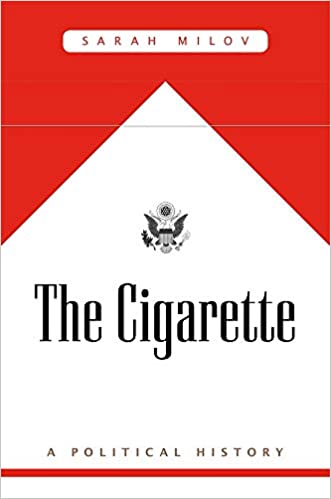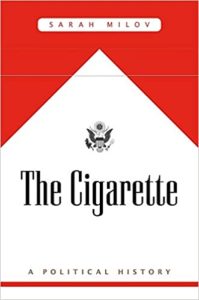

Sarah Milov’s The Cigarette: A Political History is accurately subtitled. Milov, a history professor at the University of Virginia, has written a first-rate history of the interaction between tobacco companies, tobacco growers, and various levels of government over almost a century. She delves carefully into the details of those interactions and tells you more than you probably want to know about the many decades of interaction.
While she makes her own dislike of cigarette smoking clear, that interferes only occasionally with her narrative. She appears to be an honest broker. The history itself is fascinating, whether it be about the federal government’s attempt to cartelize tobacco growers early in the 20th century to give them more power in their dealings with cigarette manufacturers, the federal government’s promotion of cigarettes to troops during World War II, the many years it took for governments to ban cigarettes from workplaces, or the 1998 Master Settlement Agreement (MSA) under which tobacco companies agreed to fork over hundreds of billions of dollars to state governments. Unfortunately, Milov misses the significance of some early moves the cigarette companies themselves made to actually publicize the hazards of their competitors’ cigarettes. And, possibly because she likes the result, she doesn’t fully appreciate the significance of the tobacco company cartel formed by the MSA.
These are the opening two paragraphs of David R. Henderson, “The Twists and Turns of Tobacco Politics,” Regulation, Summer 2020.
Another excerpt:
It is common for analysts who oppose a particular program or industry to accept all criticism of that industry even when the criticisms are weak or off-target. Milov’s work is refreshingly free of that problem. She even makes gentle fun of her fellow tobacco critics when they overstep.
A case in point is her discussion of anti-smoking activist John Banzhaf of George Washington University Law School. About his 1969 petition to separate smokers and nonsmokers on flights, she writes, “Following a time-honored pattern of framing children as the primary beneficiary of government protections, Banzhaf’s petition also observed that large numbers of American children suffered from asthma.” She later refers to his petition as “an invitation to imagine turbulent skies indeed: cardiac arrests, wheezing children, and emotional tantrums by frazzled passengers pushed over the edge by the smoker across the aisle.” She also doesn’t hesitate to note that in a Chicago “smoker’s court” that was established to hear cases of people who illegally smoked on government transportation, only two of the 50 cases heard by a judge involved white defendants.
My own attitude to smoking in restaurants:
Having said all this, I should note that I personally benefit from the government crackdown on cigarettes. I had some health problems at age 16 because of my father’s smoking cigars. My doctor at the time told me never to take up smoking. I didn’t. I didn’t realize just how much I had gained from smoke-free restaurants in California, starting in 1995, until I entered the nonsmoking section of a restaurant in Amsterdam in 1999 and had to leave immediately because of the smoke.
And finally:
Conclusion / When I saw the positive blurb on Milov’s back cover by Nancy MacLean, author of Democracy in Chains, I wondered “Uh-oh, is this book going to be as badly researched and as prejudiced as MacLean’s hatchet job on James Buchanan?” (See “Buchanan the Evil Genius,” Fall 2017.) Fortunately, the answer is no. When it comes to history, Milov is old-school. She carefully went through boxes of documents to tell an interesting and well-sourced tale. Her own biases against cigarettes are on display, but they are no worse than the usual biases that historians—and most academics—bring to their work. What would have made the book substantially better is if she had paid more attention to the economics literature.
Read the whole thing, especially if you want a response to your comment.

READER COMMENTS
Alan Goldhammer
Jun 22 2020 at 10:11am
I remember our family flying back east to visit relatives in the summer of 1964. Smoking was allowed on airplanes and with the meal, all the adults received a small three pack of cigarettes (I cannot remember which brand). Also Philip Morris (now part of Altria) sent a pack of Marlboros out with their annual report (my dad was a shareholder).
Good thoughtful review of the book! The only thing I would add, and maybe Ms. Milov covers it, is that the polynuclear aromatic hrydocarbons are the putative carcinogens created in cigarette smoke. One of my good friends in grad school back in the early 1970s did his PhD work on a new approach to quantifying levels of them. He also did some groundbreaking research on the levels of these in marijuana smoke which is an interesting but too lengthy story for this response.
Comments are closed.